Mazda CX-9 (2022 year). Manual in english — page 13
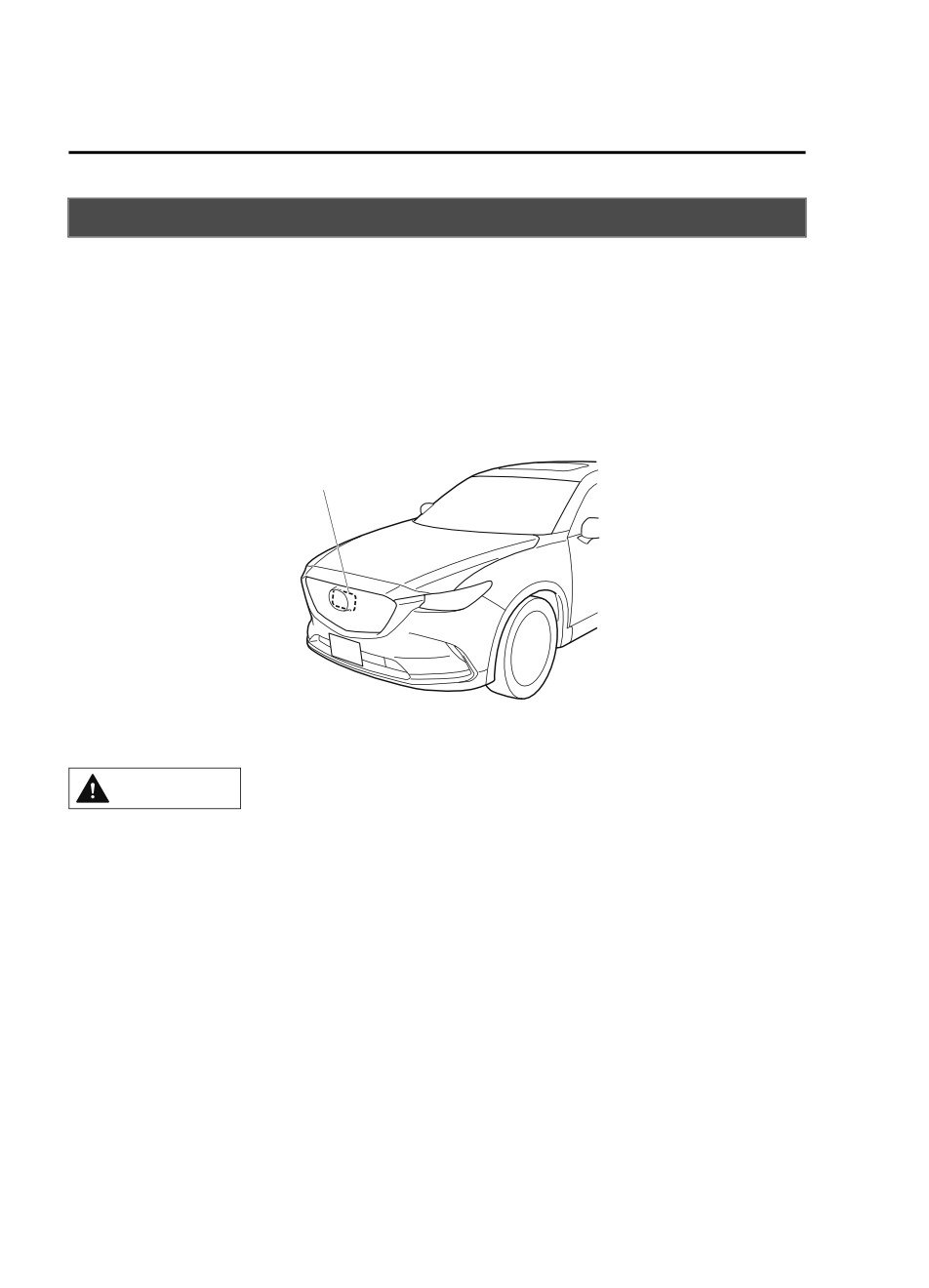
When Driving
i-ACTIVSENSE
Radar Sensor (Front)*
Your vehicle is equipped with a radar sensor (front).
The following systems also use the radar sensor (front).
Distance Recognition Support System (DRSS)
Mazda Radar Cruise Control with Stop & Go function (MRCC with Stop & Go function)
Smart Brake Support (SBS)
The radar sensor (front) functions by detecting the radio waves reflected off a vehicle ahead
or an obstruction sent from the radar sensor.
The radar sensor (front) is mounted behind the front emblem.
Radar sensor (front)
If “Front Radar Sensor Blocked” is displayed in the multi-information display of the
instrument cluster, clean the area around the radar sensor (front).
CAUTION
Heed the following precautions to assure correct operation of each system.
¾ Do not adhere stickers (including transparent stickers) to the surface of the radiator grille
and front emblem in and around the radar sensor (front), and do not replace the radiator
grille and front emblem with any product that is not a genuine product designed for use
with the radar sensor (front).
¾ The radar sensor (front) includes a function for detecting soiling of the radar sensor's front
surface and informing the driver, however, depending on the conditions, it may require
time to detect or it may not detect plastic shopping bags, ice or snow. If this occurs, the
system may not operate correctly, therefore always keep the radar sensor (front) clean.
¾ Do not install a grille guard.
¾ If the front part of the vehicle has been damaged in a vehicle accident, the position of the
radar sensor (front) may have moved. Stop the system immediately and always have the
vehicle inspected at an Authorized Mazda Dealer.
4-228
*Some models.
When Driving
i-ACTIVSENSE
¾ Do not use the front bumper to push other vehicles or obstructions such as when pulling
out of a parking space. Otherwise, the radar sensor (front) could be hit and its position
deviated.
¾ Do not remove, disassemble, or modify the radar sensor (front).
¾ For repairs, replacement or paint work around the radar sensor (front), consult an
Authorized Mazda Dealer.
¾ Do not modify the suspension. If the suspension are modified, the vehicle's posture could
change and the radar sensor (front) may not be able to correctly detect a vehicle ahead or
an obstruction.
NOTE
Under the following conditions, the radar sensor (front) may not be able to detect vehicles
ahead or obstructions correctly and each system may not operate normally.
The rear surface of a vehicle ahead does not reflect radio waves effectively, such as an
unloaded trailer or an automobile with a loading platform covered by a soft top,
vehicles with a hard plastic tailgate, and round-shaped vehicles.
Vehicles ahead with low vehicle height and thus less area for reflecting radio waves.
Visibility is reduced due to a vehicle ahead casting off water, snow, or sand from its tires
and onto your windshield.
The luggage compartment is loaded with heavy objects or the rear passenger seats are
occupied.
Ice, snow, or soiling is on the front surface of the front emblem.
During inclement weather such as rain, snow, or sand storms.
When driving near facilities or objects emitting strong radio waves.
Under the following conditions, the radar sensor (front) may not be able to detect vehicles
ahead or obstructions.
The beginning and end of a curve.
Roads with continuous curves.
Narrow lane roads due to road construction or lane closures.
The vehicle ahead enters the radar sensor's blind spot.
The vehicle ahead is running abnormally due to accident or vehicle damage.
Roads with repeated up and down slopes
Driving on poor roads or unpaved roads.
The distance between your vehicle and the vehicle ahead is extremely short.
A vehicle suddenly comes close such as by cutting into the lane.
To prevent incorrect operation of the system, use tires of the same specified size,
manufacturer, brand, and tread pattern on all four wheels. In addition, do not use tires
with significantly different wear patterns or tire pressures on the same vehicle (Including
the temporary spare tire).
If the battery power is weak, the system may not operate correctly.
4-229
When Driving
i-ACTIVSENSE
When driving on roads with little traffic and few vehicles ahead or obstructions for the
radar sensor (front) to detect, “Front Radar Sensor Blocked” may be temporarily
displayed, however, this does not indicate a problem.
The radar sensors are regulated by the relevant radio wave laws of the country in which
the vehicle is driven. If the vehicle is driven abroad, authorization from the country in
which the vehicle is driven may be required.
4-230
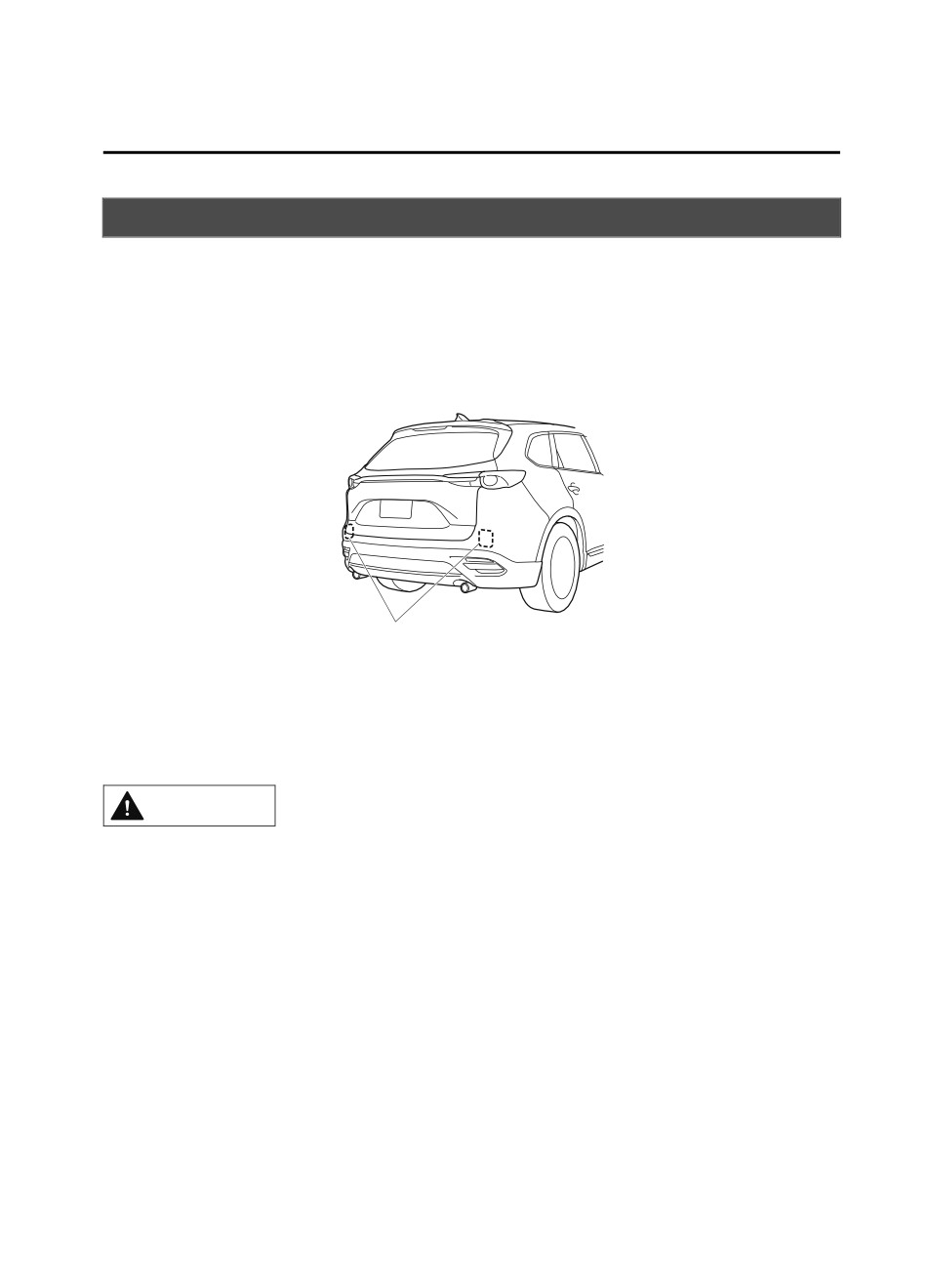
When Driving
i-ACTIVSENSE
Radar Sensors (Rear)*
Your vehicle is equipped with radar sensors (rear). The following systems also use the radar
sensors (rear).
Blind Spot Monitoring (BSM)
Rear Cross Traffic Alert (RCTA)
The radar sensors (rear) function by detecting the radio waves reflected off a vehicle
approaching from the rear or an obstruction sent from the radar sensor.
Radar sensors (rear)
The radar sensors (rear) are installed inside the rear bumper, one each on the left and right
sides.
Always keep the surface of the rear bumper near the radar sensors (rear) clean so that the
radar sensors (rear) operate normally. Also, do not apply items such as stickers.
Refer to Exterior Care on page 6-52.
CAUTION
If the rear bumper receives a severe impact, the system may no longer operate normally. Stop
the system immediately and have the vehicle inspected at an Authorized Mazda Dealer.
NOTE
The detection ability of the radar sensors (rear) has limitations. In the following cases,
the detection ability may lower and the system may not operate normally.
The rear bumper near the radar sensors (rear) has become deformed.
Snow, ice or mud adheres to the radar sensors (rear) on the rear bumper.
Under bad weather conditions such as rain, snow and fog.
Under the following conditions, the radar sensors (rear) cannot detect target objects or it
may be difficult to detect them.
Stationary objects on a road or a road side such as small, two-wheeled vehicles,
bicycles, pedestrians, animals, and shopping carts.
*Some models.
4-231
When Driving
i-ACTIVSENSE
Vehicle shapes which do not reflect radar waves well such as empty trailers with a low
vehicle height and sports cars.
Vehicles are shipped with the direction of the radar sensors (rear) adjusted for each
vehicle to a loaded vehicle condition so that the radar sensors (rear) detect approaching
vehicles correctly. If the direction of the radar sensors (rear) has deviated for some
reason, have the vehicle inspected at an Authorized Mazda Dealer.
For repairs or replacement of the radar sensors (rear), or bumper repairs, paintwork, and
replacement near the radar sensors, consult an Authorized Mazda Dealer.
Turn off the system while pulling a trailer or while an accessory such as a bicycle carrier
is installed to the rear of the vehicle. Otherwise, the radio waves emitted by the radar will
be blocked causing the system to not operate normally.
The radar sensors are regulated by the relevant radio wave laws of the country in which
the vehicle is driven. If the vehicle is driven abroad, authorization from the country in
which the vehicle is driven may be required.
4-232
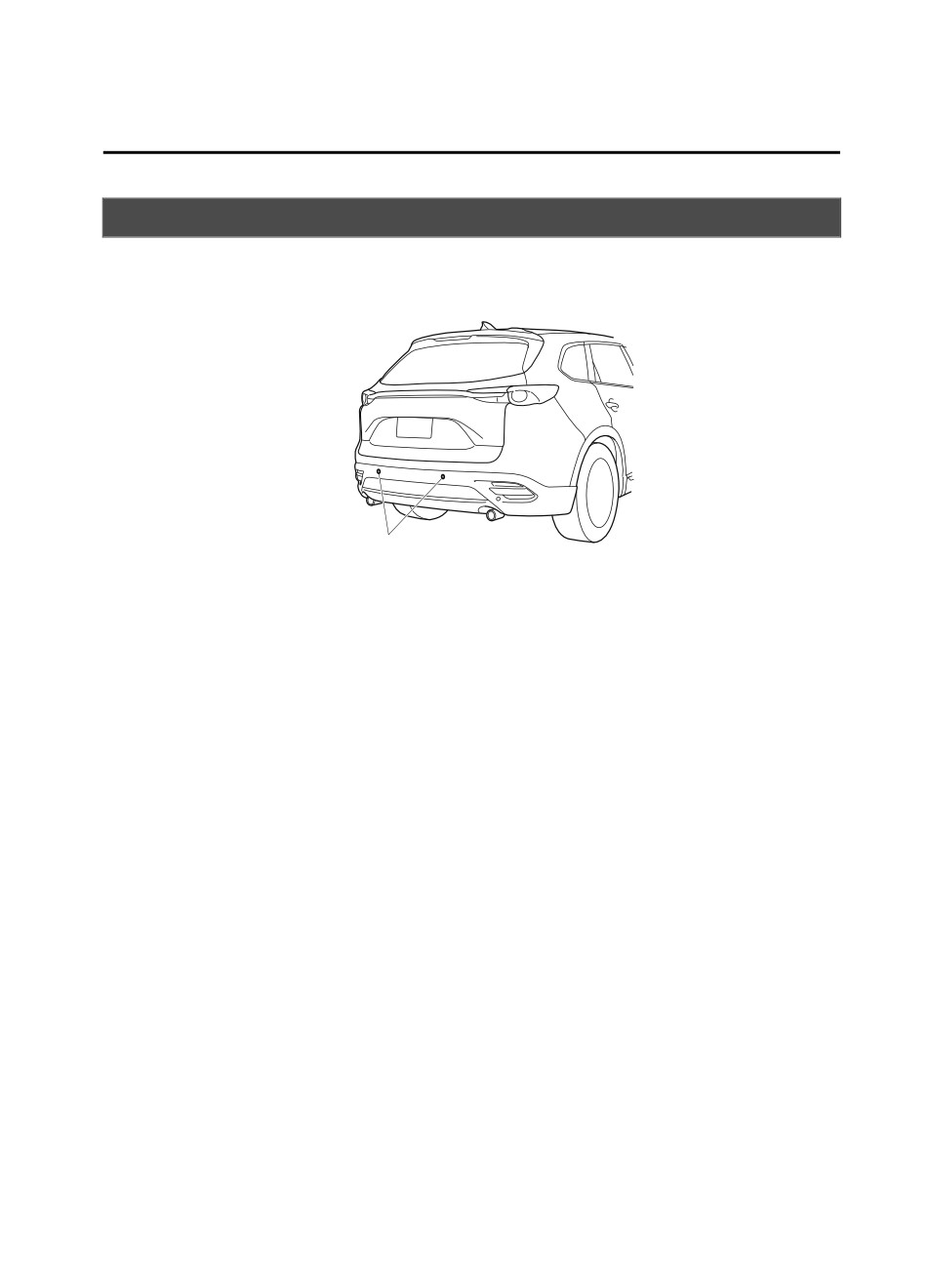
When Driving
i-ACTIVSENSE
Ultrasonic Sensor (Rear)*
The ultrasonic sensors (rear) function by emitting ultrasonic waves which are reflected off
obstructions at the rear and the returning ultrasonic waves are picked up by the ultrasonic
sensors (rear).
Ultrasonic sensor (rear)
The ultrasonic sensors (rear) are mounted in the rear bumper.
*Some models.
4-233
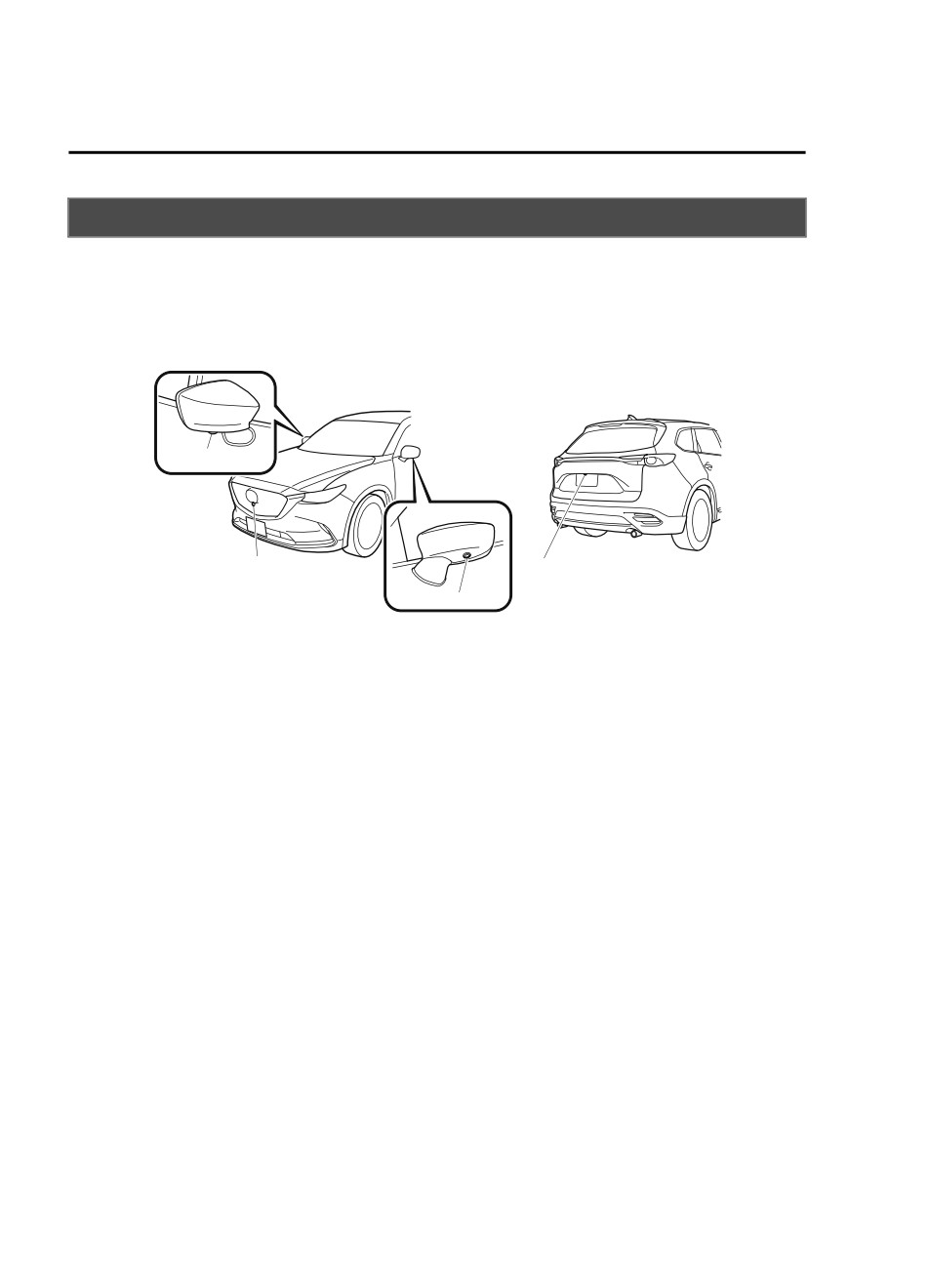
When Driving
i-ACTIVSENSE
Front Camera/Side Cameras/Rear Camera*
Your vehicle is equipped with a front camera, side cameras, and a rear camera. The 360°
View Monitor uses each camera.
The front camera, side cameras, and rear camera shoot images of the area surrounding the
vehicle.
Each camera is installed to the following positions.
Side camera
Front camera
Rear camera
Side camera
4-234
*Some models.

When Driving
Cruise Control
Cruise Control*
With cruise control, you can set and automatically maintain any speed of more than about
25 km/h (16 mph).
WARNING
Do not use the cruise control under the following conditions:
Using the cruise control under the following conditions is dangerous and could result in loss
of vehicle control.
¾ Hilly terrain
¾ Steep inclines
¾ Heavy or unsteady traffic
¾ Slippery or winding roads
¾ Similar restrictions that require inconsistent speed
▼ Cruise Control Switch
RES/+ switch
ON switch
SET/- switch
OFF/CANCEL switch
NOTE
If your Mazda has the following steering switch, your Mazda is equipped with the Mazda
Radar Cruise Control with Stop & Go function (MRCC with Stop & Go function) system.
*Some models.
4-235
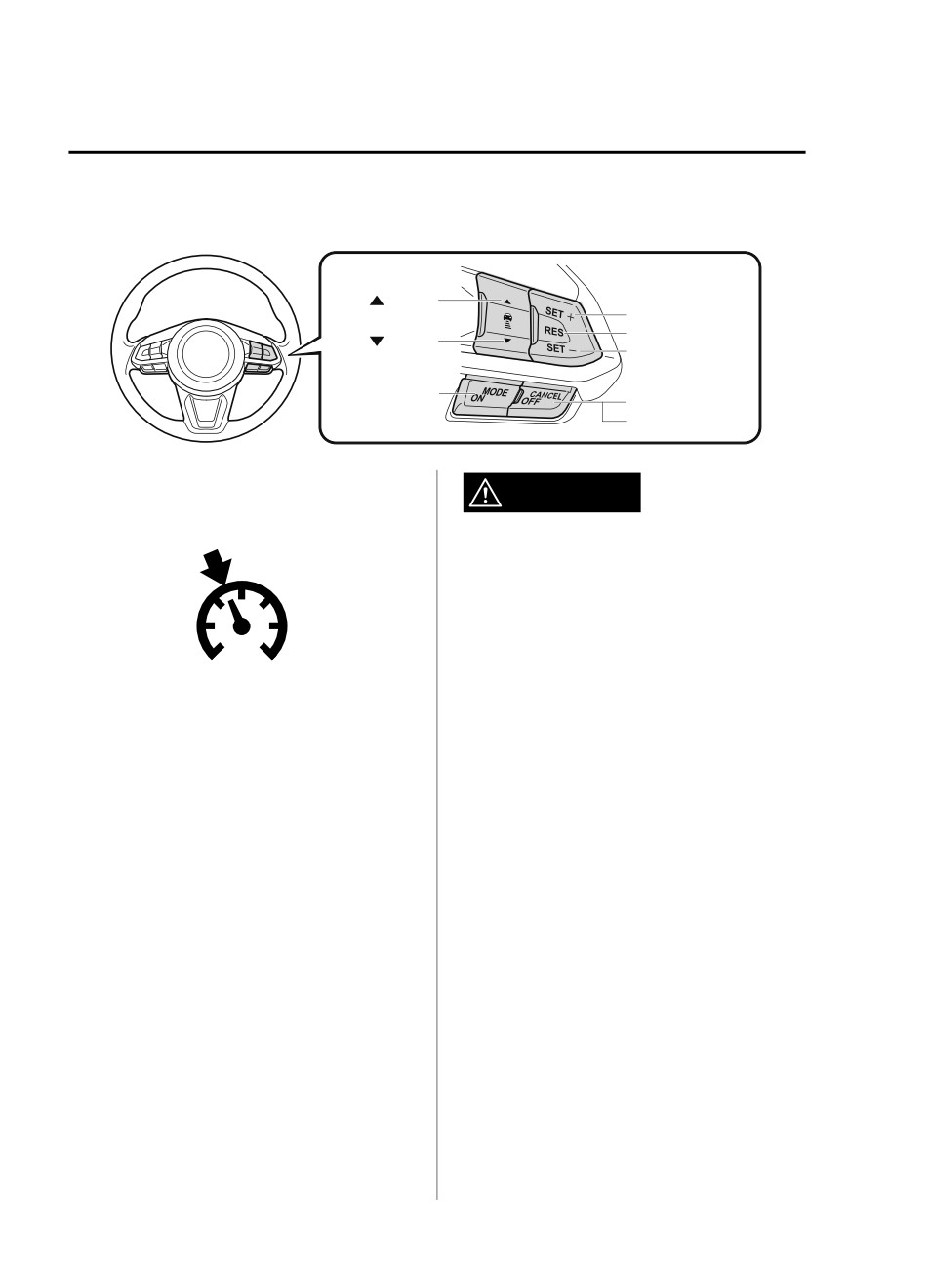
When Driving
Cruise Control
Refer to Mazda Radar Cruise Control with Stop & Go function (MRCC with Stop & Go
function) on page 4-131.
switch
SET+ switch
switch
RES switch
SET- switch
MODE switch
CANCEL switch
OFF switch
▼ Cruise Main Indication (White)/
WARNING
Cruise Set Indication (Green)
Always turn off the cruise control system
when it is not in use:
Leaving the cruise control system in an
activation-ready state while the cruise
control is not in use is dangerous as the
cruise control could unexpectedly activate
The indication has 2 colors.
if the activation button is accidentally
pressed, and result in loss of vehicle control
Cruise Main Indication (White)
and an accident.
The indication turns on (white) when the
cruise control system is activated.
NOTE
When the ignition is switched OFF, the
Cruise Set Indication (Green)
system status before it was turned off is
The indication turns on (green) when a
maintained. For example, if the ignition is
cruising speed has been set.
switched OFF with the cruise control
system operable, the system will be
▼ Activation/Deactivation
operable when the ignition is switched ON
To activate the system, press the ON
the next time.
switch. The cruise main indication (white)
▼ To Set Speed
is displayed.
To deactivate the system, press the OFF/
1. Activate the cruise control system by
CANCEL switch.
pressing the ON switch. The cruise
The cruise main indication (white) turns
main indication (white) is displayed.
off.
2. Accelerate to the desired speed, which
must be more than 25 km/h (16 mph).
3. Set the cruise control by pressing the
SET/ switch at the desired speed. The
4-236

When Driving
Cruise Control
cruise control is set at the moment the
The vehicle speed preset using the cruise
SET/ switch is pressed. Release the
control is displayed in the instrument
accelerator pedal simultaneously. The
cluster.
cruise set indication (green) is
Instrument Cluster
displayed.
Type A
*1
NOTE
The cruise control speed setting cannot
be performed under the following
conditions:
The selector lever is in the P or N
position.
*1: Needle indicates set speed.
The parking brake is applied.
Type B
Type C
Release the SET/ or RES/ switch at
the desired speed, otherwise the speed
will continue increasing while the RES/
switch is pressed and held, and
continue decreasing while the SET/
switch is pressed and held (except when
Active Driving Display
the accelerator pedal is depressed).
On a steep grade, the vehicle may
momentarily slow down while
ascending, or speed up while
▼ To Increase Cruising Speed
descending.
Follow either of these procedures.
The cruise control will cancel if the
vehicle speed decreases below 21 km/h
To increase speed using cruise control
(13 mph) when climbing a steep grade.
switch
The cruise control may cancel at about
Press the RES/ switch and hold it. Your
15 km/h (9 mph) below the preset speed
vehicle will accelerate. Release the switch
such as when climbing a long, steep
at the desired speed.
grade.
Press the RES/ switch and release it
immediately to adjust the preset speed.
Multiple operations will increase the
preset speed according to the number of
times it is operated.
Increasing speed with a single RES/
switch operation
Instrument cluster display for vehicle
speed indicated in km/h: 1 km/h (0.6 mph)
4-237
When Driving
Cruise Control
Instrument cluster display for vehicle
If vehicle speed is below 25 km/h (16
speed indicated in mph: 1 mph (1.6 km/h)
mph), increase the vehicle speed up to 25
km/h (16 mph) or more and press the RES/
To increase speed using accelerator
switch.
pedal
▼ To Temporarily Cancel
Depress the accelerator pedal to accelerate
to the desired speed. Press the SET/
To temporarily cancel the system, use one
switch and release it immediately.
of these methods:
NOTE
Slightly depress the brake pedal.
Accelerate if you want to speed up
Press the OFF/CANCEL switch.
temporarily when the cruise control is on.
If the RES/ switch is pressed when the
Greater speed will not interfere with or
vehicle speed is 25 km/h (16 mph) or
change the set speed. Take your foot off
higher, the system reverts to the previously
the accelerator to return to the set speed.
set speed.
▼ To Decrease Cruising Speed
NOTE
Press the SET/ switch and hold it. The
If any of the following conditions occur,
vehicle will gradually slow.
the cruise control system is temporarily
Release the switch at the desired speed.
canceled.
Press the SET/ switch and release it
The parking brake is applied.
The selector lever is in the P or N
immediately to adjust the preset speed.
position.
Multiple operations will decrease the
preset speed according to the number of
When the cruise control system is
temporarily canceled by even one of the
times it is operated.
applicable cancel conditions, the speed
Decreasing speed with a single SET/
cannot be re-set.
switch operation
The cruise control cannot be cancelled
Instrument cluster display for vehicle
while driving in manual mode (selector
speed indicated in km/h: 1 km/h (0.6 mph)
lever shifted from D to M position).
Instrument cluster display for vehicle
Therefore, engine braking will not be
speed indicated in mph: 1 mph (1.6 km/h)
applied even if the transaxle is shifted
down to a lower gear. If deceleration is
▼ To Resume Cruising Speed at More
required, lower the set speed or depress
Than 25 km/h (16 mph)
the brake pedal.
If the cruise control system temporarily
▼ To Deactivate
canceled (such as applying the brake
pedal) and the system is still activated, the
When a cruising speed has been set
most recent set speed will automatically
(cruise set indication (green) turns on)
resume when the RES/ switch is pressed.
Long-press the OFF/CANCEL switch or
press the OFF/CANCEL switch 2 times.
4-238
When Driving
Cruise Control
When a cruising speed has not been set
(cruise main indication (white) turns
on)
Press the OFF/CANCEL switch.
4-239
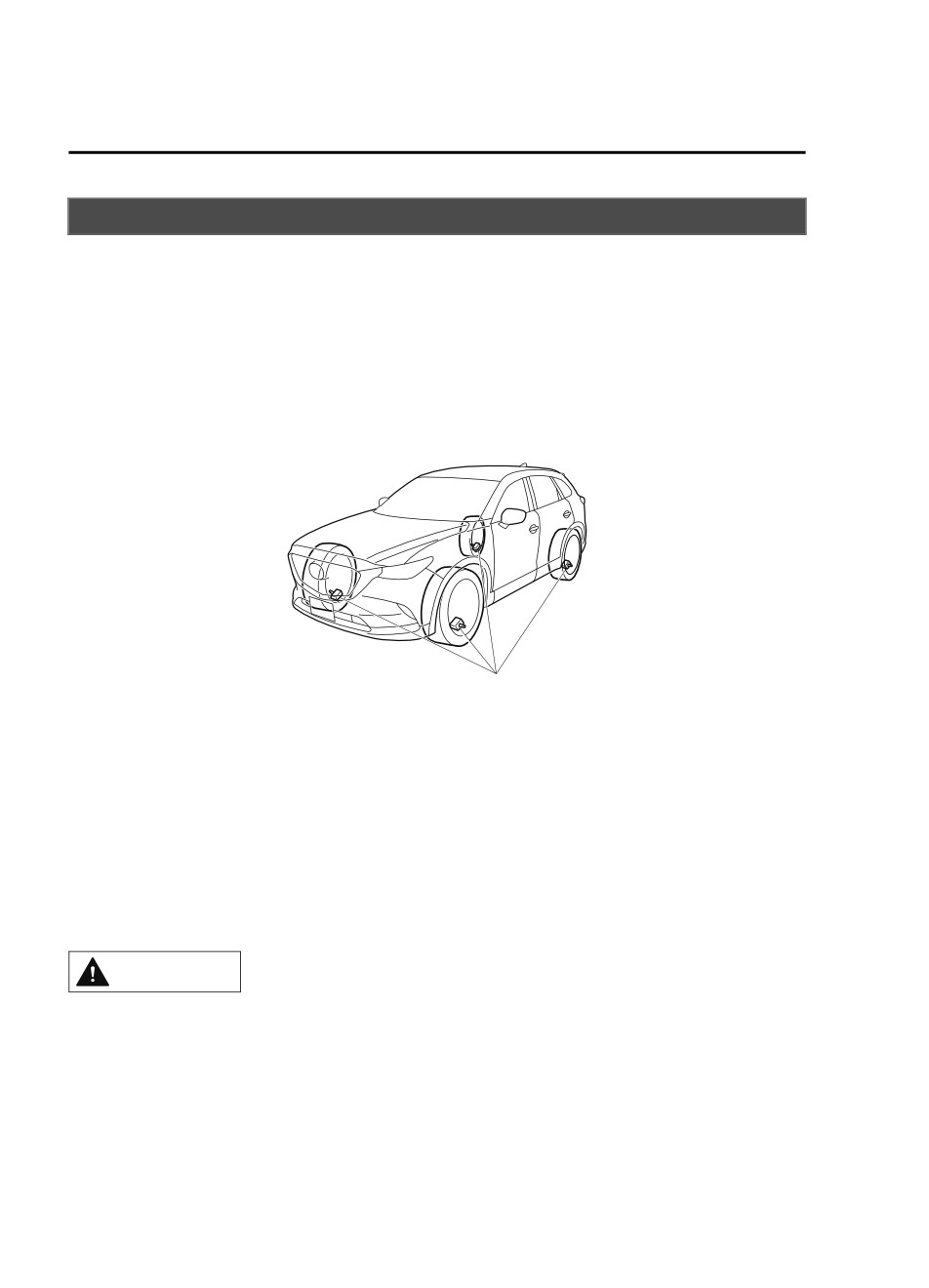
When Driving
Tire Pressure Monitoring System
Tire Pressure Monitoring System
The Tire Pressure Monitoring System (TPMS) monitors the pressure for each tire.
If tire pressure is too low in one or more tires, the system will inform the driver via the
warning light in the instrument cluster and by the warning beep sound.
Refer to Contact Authorized Mazda Dealer and Have Vehicle Inspected on page 7-31.
Refer to Taking Action on page 7-36.
Refer to Tire Inflation Pressure Warning Beep on page 7-48.
The tire pressure sensors installed on each wheel send tire pressure data by radio signal to
the receiver unit in the vehicle.
Tire pressure sensors
NOTE
When the ambient temperature is low due to seasonal changes, tire temperatures are also
lower. When the tire temperature decreases, the air pressure decreases as well. The TPMS
warning light may illuminate more frequently. Visually inspect the tires daily before driving,
and check tire pressures monthly with a tire pressure gauge. When checking tire pressures,
use of a digital tire pressure gauge is recommended.
TPMS does not alleviate your need to check the pressure and condition of all four tires
regularly.
CAUTION
¾ Each tire, including the spare (if provided), should be checked monthly when cold and
inflated to the inflation pressure recommended by the vehicle manufacturer on the vehicle
placard or tire inflation pressure label. (If your vehicle has tires of a different size than the
size indicated on the vehicle placard or tire inflation pressure label, you should determine
the proper tire inflation pressure for those tires.)
4-240
When Driving
Tire Pressure Monitoring System
As an added safety feature, your vehicle has been equipped with a tire pressure monitoring
system (TPMS) that illuminates a low tire pressure telltale when one or more of your tires is
significantly under-inflated. Accordingly, when the low tire pressure telltale illuminates, you
should stop and check your tires as soon as possible, and inflate them to the proper
pressure. Driving on a significantly under-inflated tire causes the tire to overheat and can
lead to tire failure. Under-inflation also reduces fuel efficiency and tire tread life, and may
affect the vehicle's handling and stopping ability.
Please note that the TPMS is not a substitute for proper tire maintenance, and it is the
driver's responsibility to maintain correct tire pressure, even if under-inflation has not
reached the level to trigger illumination of the TPMS low tire pressure telltale.
Your vehicle has also been equipped with a TPMS malfunction indicator to indicate when
the system is not operating properly.
The TPMS malfunction indicator is combined with the low tire pressure telltale. When the
system detects a malfunction, the telltale will flash for approximately one minute and then
remain continuously illuminated. This sequence will continue upon subsequent vehicle
start-ups as long as the malfunction exists. When the malfunction indicator is illuminated,
the system may not be able to detect or signal low tire pressure as intended. TPMS
malfunctions may occur for a variety of reasons, including the installation of replacement
or alternate tires or wheels on the vehicle that prevent the TPMS from functioning properly.
Always check the TPMS malfunction telltale after replacing one or more tires or wheels on
your vehicle to ensure that the replacement or alternate tires and wheels allow the TPMS to
continue to function properly.
¾ To avoid false readings, the system samples for a little while before indicating a problem. As
a result it will not instantaneously register a rapid tire deflation or blow out.
▼ System Error Activation
When using the following devices in the
vehicle that may cause radio
When the warning light flashes, there may
interference with the receiver unit.
be a system malfunction. Consult an
Authorized Mazda Dealer.
A digital device such as a personal
A system error activation may occur in the
computer.
following cases:
A current converter device such as a
DC-AC converter.
When there is equipment or a device
When excess snow or ice adheres to the
near the vehicle using the same radio
vehicle, especially around the wheels.
frequency as that of the tire pressure
When the tire pressure sensor batteries
sensors.
are exhausted.
When a metallic device such as a
When using a wheel with no tire
non-genuine navigation system is
pressure sensor installed.
equipped near the center of the
When using tires with steel wire
dashboard, which may block radio
reinforcement in the sidewalls.
signals from the tire pressure sensor to
the receiver unit.
When using tire chains.
4-241
When Driving
Tire Pressure Monitoring System
▼ Tires and Wheels
3. After about 15 minutes, drive the
vehicle at a speed of at least 25 km/h
(16 mph) for 10 minutes and the tire
CAUTION
pressure sensor ID signal code will be
registered automatically.
When inspecting or adjusting the tire air
pressures, do not apply excessive force to
NOTE
the stem part of the wheel unit. The stem
If the vehicle is driven within about 15
part could be damaged.
minutes of changing tires, the tire pressure
monitoring system warning light will flash
Changing tires and wheels
because the sensor ID signal code would
The following procedure allows the TPMS
not have been registered. If this happens,
to recognize a tire pressure sensor's unique
park the vehicle for about 15 minutes,
ID signal code whenever tires or wheels
after which the sensor ID signal code will
are changed, such as changing to and from
register upon driving the vehicle for 10
winter tires.
minutes.
NOTE
Replacing tires and wheels
Each tire pressure sensor has a unique ID
signal code. The signal code must be
CAUTION
registered with the TPMS before it can
work. The easiest way to do it is to have
¾ When replacing/repairing the tires or
an Authorized Mazda Dealer, change your
wheels or both, have the work done by
tire and complete ID signal code
an Authorized Mazda Dealer, or the tire
registration.
pressure sensors may be damaged.
When having tires changed at an
¾ The wheels equipped on your Mazda are
Authorized Mazda Dealer
specially designed for installation of the
tire pressure sensors. Do not use
When an Authorized Mazda Dealer,
non-genuine wheels, otherwise it may
changes your vehicle's tires, they will
not be possible to install the tire pressure
complete the tire pressure sensor ID signal
sensors.
code registration.
Be sure to have the tire pressure sensors
installed whenever tires or wheels are
When changing tires yourself
replaced.
If you or someone else changes tires, you
When having a tire or wheel or both
or someone else can also undertake the
replaced, the following types of tire
steps for the TPMS to complete the ID
pressure sensor installations are possible.
signal code registration.
The tire pressure sensor is removed
1. After tires have been changed, switch
from the old wheel and installed to the
the ignition ON, then back to ACC or
new one.
OFF.
2. Wait for about 15 minutes.
4-242
When Driving
Tire Pressure Monitoring System
The same tire pressure sensor is used
with the same wheel. Only the tire is
replaced.
A new tire pressure sensor is installed to
a new wheel.
NOTE
The tire pressure sensor ID signal code
must be registered when a new tire
pressure sensor is purchased. For
purchase of a tire pressure sensor and
registration of the tire pressure sensor
ID signal code, consult an Authorized
Mazda Dealer.
When reinstalling a previously removed
tire pressure sensor to a wheel, replace
the grommet (seal between valve body/
sensor and wheel) for the tire pressure
sensor.
4-243
When Driving
Rear View Monitor (Mazda Connect (Type A))
Rear View Monitor (Mazda Connect (Type A))*
The rear view monitor provides visual images of the rear of the vehicle when reversing.
WARNING
Always drive carefully confirming the safety of the rear and the surrounding conditions by
looking directly with your eyes:
Reversing the vehicle by only looking at the screen is dangerous as it may cause an accident
or a collision with an object. The rear view monitor is only a visual assist device when
reversing the vehicle. The images on the screen may be different from the actual conditions.
CAUTION
¾ Do not use the rear view monitor under the following conditions: Using the rear view
monitor under the following conditions is dangerous and could result in injury or vehicle
damage or both.
¾ Icy or snow-covered roads.
¾ Tire chains or a temporary spare tire is installed.
¾ The liftgate is not fully closed.
¾ The vehicle is on a road incline.
¾ When the display is cold, images may course across the monitor or the screen and may be
dimmer than usual, which could cause difficulty in confirming the surrounding conditions
of the vehicle. Always drive carefully confirming the safety of the rear and the surrounding
conditions by looking directly with your eyes.
¾ Do not apply excessive force to the camera. The camera position and angle may deviate.
¾ Do not disassemble, modify, or remove it as it may no longer be waterproof.
¾ The camera cover is made of plastic. Do not apply degreasing agents, organic solvents,
wax, or glass coating agents to the camera cover. If any are spilled on the cover, wipe off
with a soft cloth immediately.
¾ Do not rub the camera cover forcefully with an abrasive or hard brush. The camera cover or
lens may be scratched which might affect the images.
NOTE
If water, snow, or mud is stuck on the camera lens, wipe it off using a soft cloth. If it
cannot be wiped off, use a mild detergent.
If the camera temperature changes rapidly (Hot to cold, cold to hot), the rear view
monitor may not operate correctly.
When replacing the tires, consult an Authorized Mazda Dealer. Replacing the tires could
result in deviation of the guide lines which appear on the display.
4-244
*Some models.
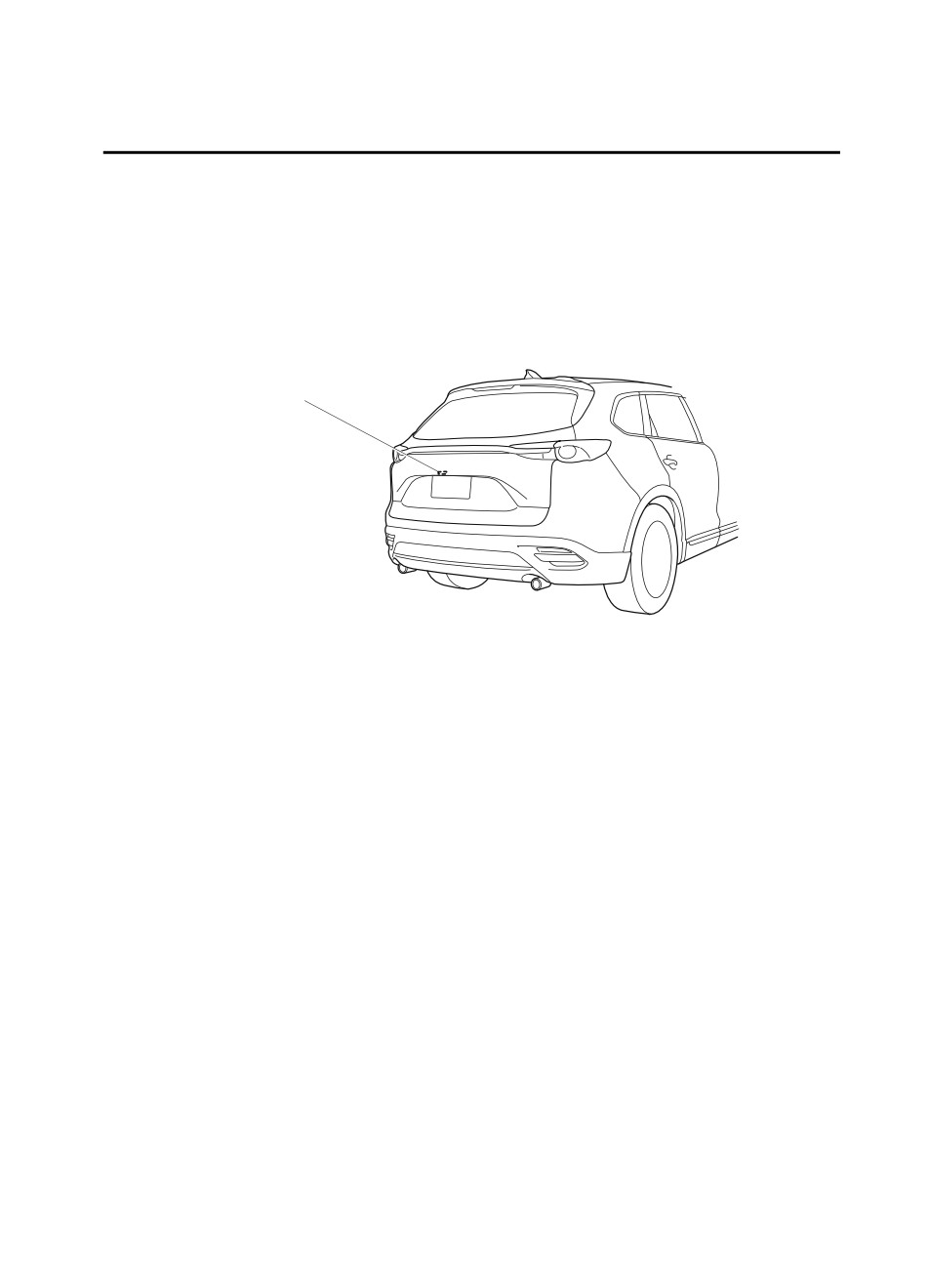
When Driving
Rear View Monitor (Mazda Connect (Type A))
If the vehicle's front, side, or rear has been involved in a collision, the alignment of the
rear view parking camera (location, installation angle) may have deviated. Always
consult an Authorized Mazda Dealer to have the vehicle inspected.
If “No camera signal.” is indicated in the display, there could be a problem with the
camera. Have your vehicle inspected at an Authorized Mazda Dealer.
▼ Rear View Parking Camera Location
Rear view parking camera
▼ Switching to the Rear View Monitor Display
Shift the selector lever to reverse (R) position with the ignition switched ON to switch the
display to the rear view monitor display.
NOTE
When the selector lever is shifted from reverse (R) position to another selector lever
position, the screen returns to the previous display.
4-245
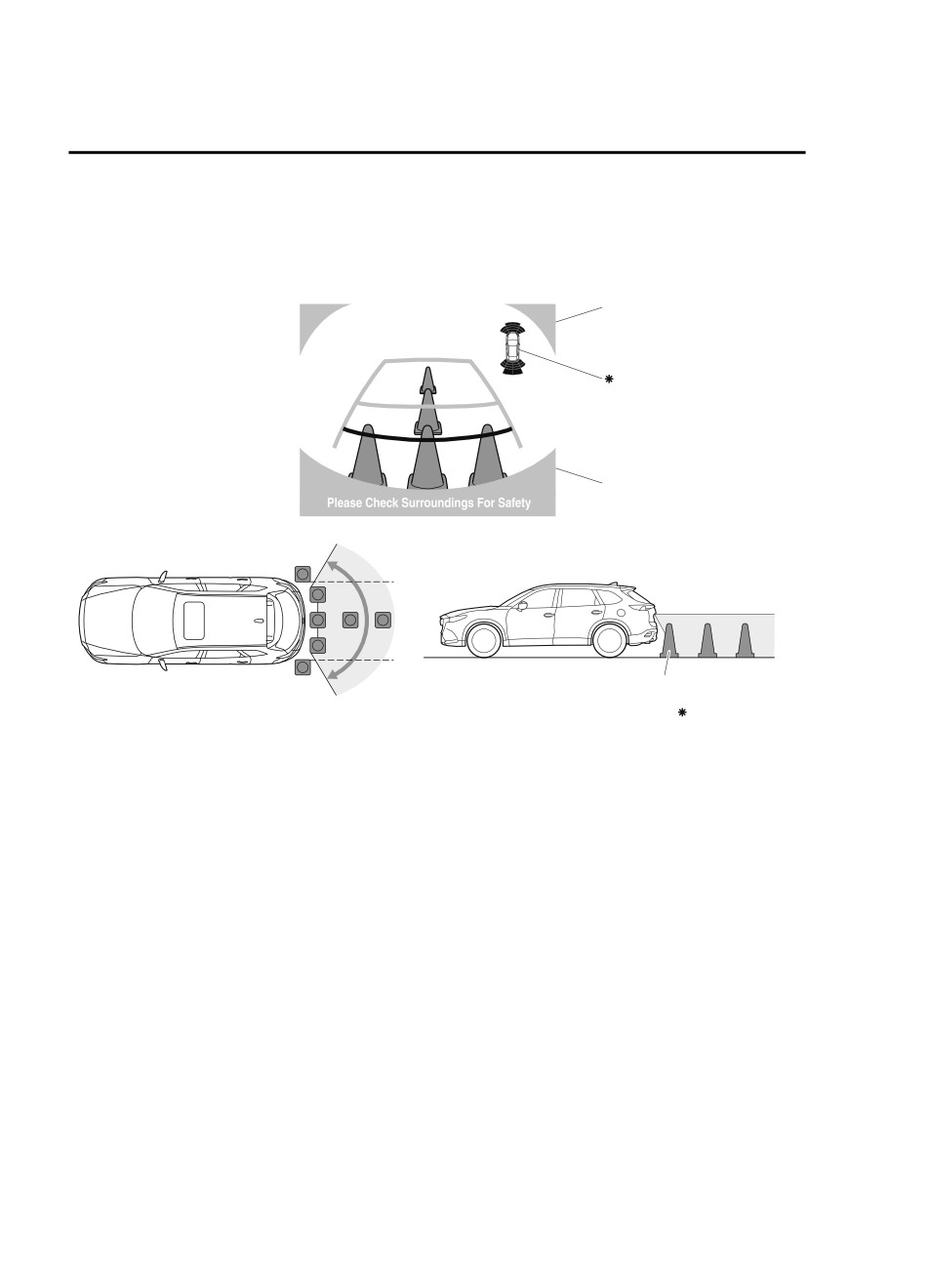
When Driving
Rear View Monitor (Mazda Connect (Type A))
▼ Displayable Range on the Screen
The images on the screen may be different from the actual conditions.
(Screen display)
Garnish
Obstruction detection
indication in parking
sensor system
Bumper
(Actual view)
Object
Some models
NOTE
The displayable range varies depending on the vehicle and road conditions.
The displayable range is limited. Objects under the bumper or around the bumper ends
cannot be displayed.
The distance appearing in the displayed image is different from the actual distance
because the rear view parking camera is equipped with a specific lens.
Some optionally installed vehicle accessories may be picked up by the camera. Do not
install any optional parts that can interfere with the camera view, such as illuminating
parts or parts made of reflective material.
It may be difficult to see the display under the following conditions, however, it does not
indicate a malfunction.
In darkened areas.
When the temperature around the lens is high/low.
When the camera is wet such as on a rainy day or during periods of high humidity.
When foreign material such as mud is stuck around the camera.
When the camera lens reflects sunlight or headlight beams.
Image display may be delayed if the temperature around the camera is low.
4-246
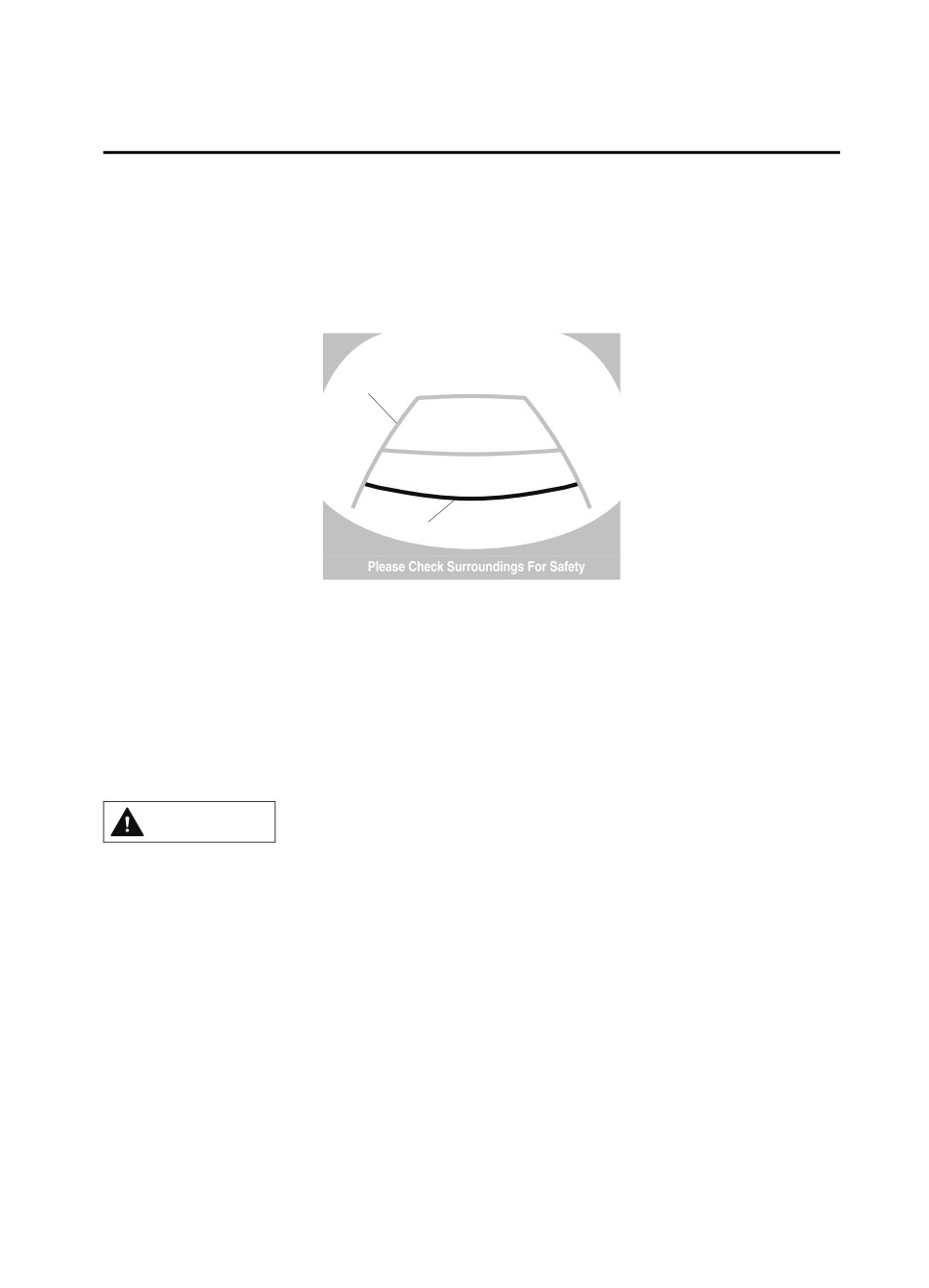
When Driving
Rear View Monitor (Mazda Connect (Type A))
▼ Viewing the Display
Guide lines which indicate the width of the vehicle (yellow) are displayed on the screen as a
reference to the approximate width of the vehicle in comparison to the width of the parking
space you are about to back into.
Use this display view for parking your vehicle in a parking space or garage.
a
b
a) Vehicle width guide lines (yellow)
These guide lines serve as a reference to the approximate width of the vehicle.
b) Distance guide lines.
These guide lines indicate the approximate distance to a point measured from the
vehicle's rear (from the end of the bumper).
The red and yellow lines indicate the points about 0.5 m (19.7 in) for the red line and
1.0 m (39.4 in) for the yellow lines from the rear bumper (at the center point of each of
the lines).
CAUTION
The guide lines on the screen are fixed lines. They are not synced to the driver's turning of the
steering wheel. Always be careful and check the area to the vehicle's rear and the surrounding
area directly with your eyes while backing up.
▼ Rear View Monitor Operation
The operation of the rear view monitor when reversing the vehicle varies depending on the
traffic, road, and vehicle conditions. The amount of steering and the timing also varies
depending on conditions, so confirm the surrounding conditions directly with your eyes and
steer the vehicle in accordance with the conditions.
Be well aware of the above cautions prior to using the rear view monitor.
NOTE
Images displayed on the monitor from the rear view parking camera are reversed images
(mirror images).
4-247

When Driving
Rear View Monitor (Mazda Connect (Type A))
1. Shift the selector lever to reverse (R) position to switch the display to the rear view
monitor display.
2. Confirming the surrounding conditions, reverse the vehicle.
(Display condition)
(Vehicle condition)
3. After your vehicle begins entering the parking space, continue backing up slowly so that
the distance between the vehicle width lines and the sides of the parking space on the
left and right are roughly equal.
4. Continue to adjust the steering wheel until the vehicle width guide lines are parallel to
the left and right sides of the parking space.
5. Once they are parallel, straighten the wheels and back your vehicle slowly into the
parking space. Continue checking the vehicle's surroundings and then stop the vehicle in
the best possible position.
(Display condition)
(Vehicle condition)
6. When the selector lever is shifted from reverse (R) to another selector lever position, the
screen returns to the previous display.
4-248
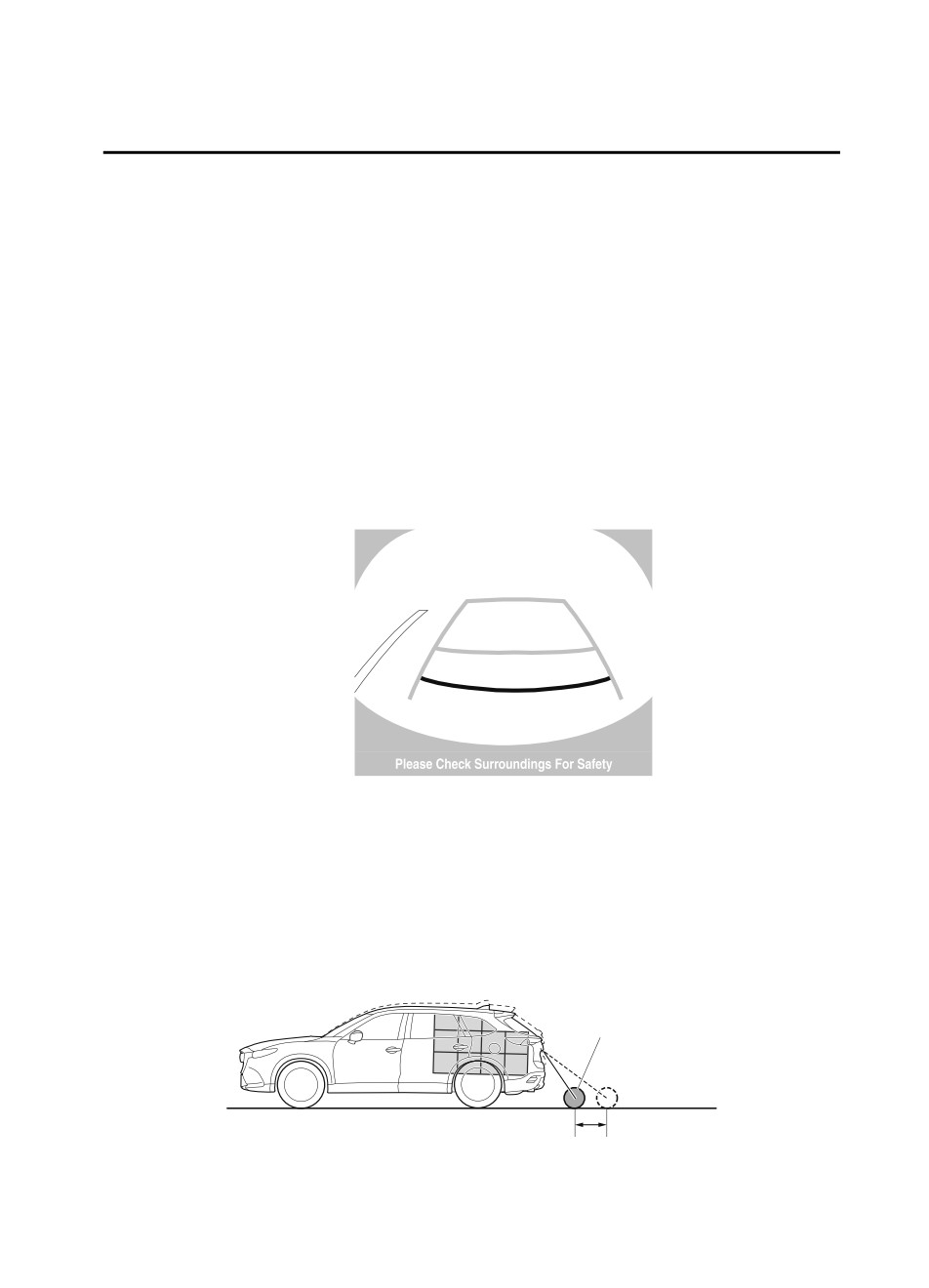
When Driving
Rear View Monitor (Mazda Connect (Type A))
NOTE
If the parking space has division lines, straighten the wheels when the vehicle width
guide lines are parallel to them.
Because there may be a difference between the displayed image, such as indicated
below, and the actual conditions when parking, always verify the safety at the rear of
the vehicle and the surrounding area directly with your eyes.
In the image of the parking space (or garage) displayed on the screen, the back end
and distance guide lines may appear aligned in the monitor, but they may not
actually be aligned on the ground.
When parking in a space with a division line on only one side of the parking space,
the division line and the vehicle width guide line appear aligned in the monitor, but
they may not actually be aligned on the ground.
▼ Variance Between Actual Road Conditions and Displayed Image
Some variance occurs between the actual road and the displayed road. Such variance in
distance perspective could lead to an accident. Note the following conditions that may cause
a variance in distance perspective.
When the vehicle is tilted due to the weight of passengers and load
When the vehicle rear is lowered, the object displayed on the screen appears farther than the
actual distance.
Object
Variance
4-249
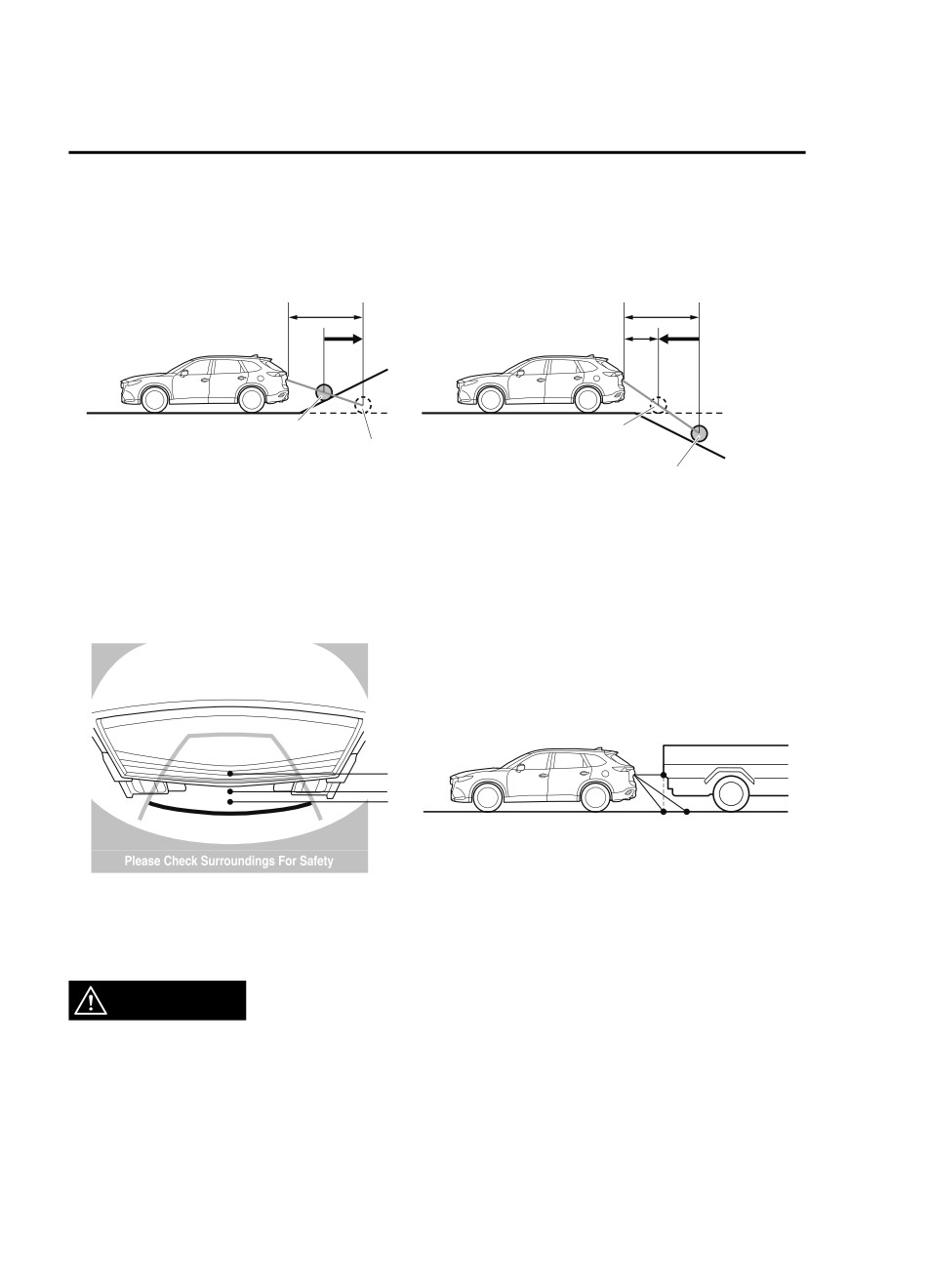
When Driving
Rear View Monitor (Mazda Connect (Type A))
When there is a steep grade behind the vehicle
When there is a steep upgrade (downgrade) behind the vehicle, the object displayed on the
screen appears farther (downgrade: closer) than the actual distance.
Appears
Appears
A
farther than
B
closer than
B
A
actual
actual
distance
distance
Object at actual position
Object on screen
Object on screen
A: Distance between the vehicle and object displayed on the screen.
Object at actual
B: Actual distance between the vehicle and object.
position
Three-dimensional object on vehicle rear
Because the distance guide lines are displayed based on a flat surface, the distance to the
three-dimensional object displayed on the screen is different from the actual distance.
(Screen display)
(Actual condition)
A
A
B
C
C B
(Actual distance) B>C=A
Sensed distance on screen A>B>C
▼ Picture Quality Adjustment
WARNING
Always adjust the picture quality of the rear view monitor while the vehicle is stopped:
Do not adjust the picture quality of the rear view monitor while driving the vehicle. Adjusting
the picture quality of the rear view monitor such as brightness, contrast, color, and tint while
driving the vehicle is dangerous as it could distract your attention from the vehicle operation
which could lead to an accident.
Picture quality adjustment can be done while the selector lever is in reverse (R).
4-250
When Driving
Rear View Monitor (Mazda Connect (Type A))
There are 4 settings which can be adjusted including, brightness, contrast, tint, and color.
When adjusting, pay sufficient attention to the vehicle surroundings.
1. Select the
icon on the screen to display the tabs.
2. Select the desired tab item.
3. Adjust the brightness, contrast, tint, and color using the slider.
If you need to reset, press the reset button.
4. Select the
icon on the screen to close the tab.
4-251
When Driving
Rear View Monitor (Mazda Connect (Type B))
Rear View Monitor (Mazda Connect (Type B))*
The rear view monitor provides visual images of the rear of the vehicle when reversing.
WARNING
Always drive carefully confirming the safety of the rear and the surrounding conditions by
looking directly with your eyes:
Reversing the vehicle by only looking at the screen is dangerous as it may cause an accident
or a collision with an object. The rear view monitor is only a visual assist device when
reversing the vehicle. The images on the screen may be different from the actual conditions.
CAUTION
¾ Do not use the rear view monitor under the following conditions: Using the rear view
monitor under the following conditions is dangerous and could result in injury or vehicle
damage or both.
¾ Icy or snow-covered roads.
¾ Tire chains or a temporary spare tire is installed.
¾ The liftgate is not fully closed.
¾ The vehicle is on a road incline.
¾ When the display is cold, images may course across the monitor or the screen and may be
dimmer than usual, which could cause difficulty in confirming the surrounding conditions
of the vehicle. Always drive carefully confirming the safety of the rear and the surrounding
conditions by looking directly with your eyes.
¾ Do not apply excessive force to the camera. The camera position and angle may deviate.
¾ Do not disassemble, modify, or remove it as it may no longer be waterproof.
¾ The camera cover is made of plastic. Do not apply degreasing agents, organic solvents,
wax, or glass coating agents to the camera cover. If any are spilled on the cover, wipe off
with a soft cloth immediately.
¾ Do not rub the camera cover forcefully with an abrasive or hard brush. The camera cover or
lens may be scratched which might affect the images.
NOTE
If water, snow, or mud is stuck on the camera lens, wipe it off using a soft cloth. If it
cannot be wiped off, use a mild detergent.
If the camera temperature changes rapidly (Hot to cold, cold to hot), the rear view
monitor may not operate correctly.
When replacing the tires, consult an Authorized Mazda Dealer. Replacing the tires could
result in deviation of the guide lines which appear on the display.
4-252
*Some models.
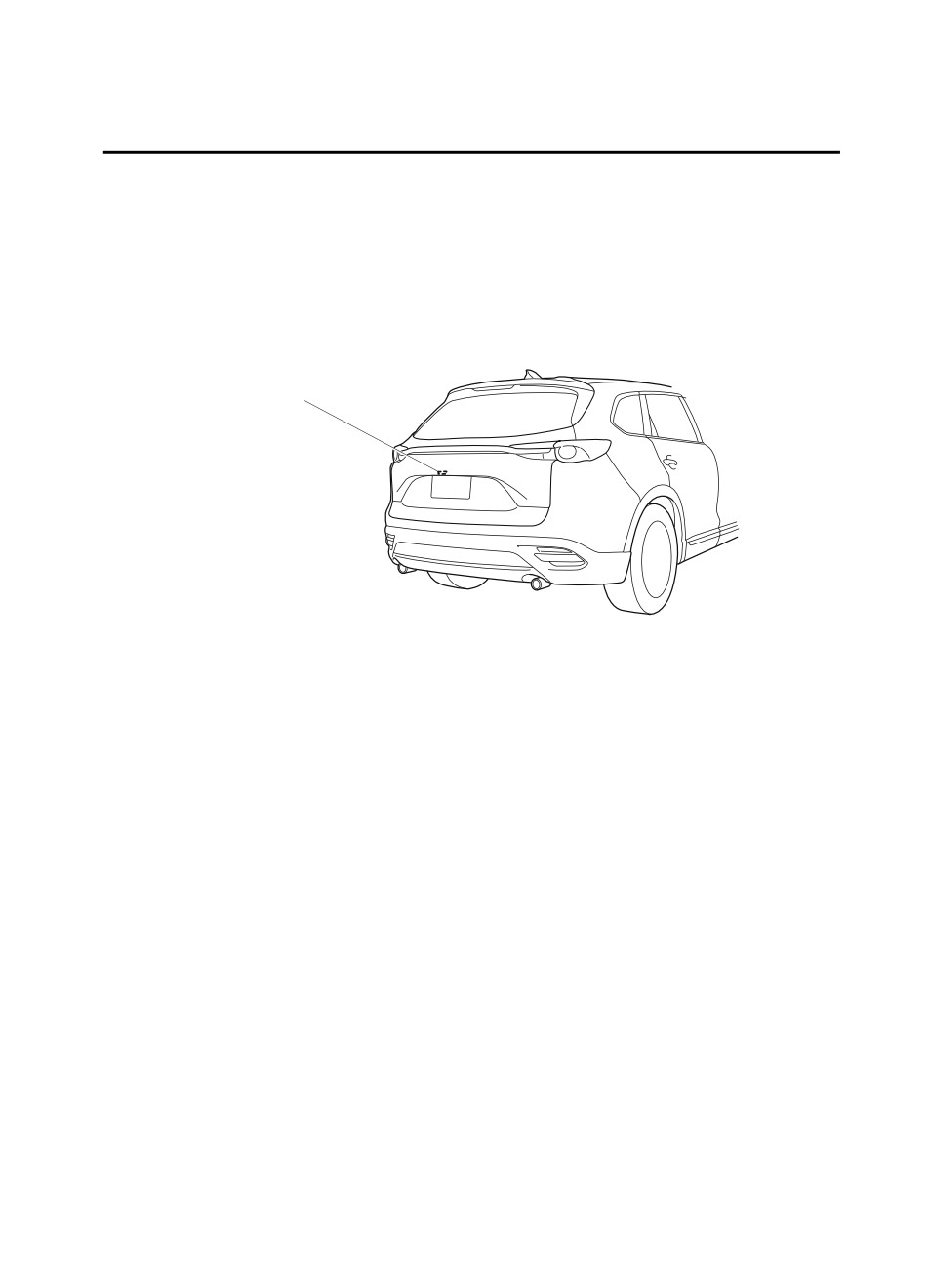
When Driving
Rear View Monitor (Mazda Connect (Type B))
If the vehicle's front, side, or rear has been involved in a collision, the alignment of the
rear view parking camera (location, installation angle) may have deviated. Always
consult an Authorized Mazda Dealer to have the vehicle inspected.
If “No camera signal.” is indicated in the display, there could be a problem with the
camera. Have your vehicle inspected at an Authorized Mazda Dealer.
▼ Rear View Parking Camera Location
Rear view parking camera
▼ Switching to the Rear View Monitor Display
Shift the selector lever to reverse (R) position with the ignition switched ON to switch the
display to the rear view monitor display.
NOTE
When the selector lever is shifted from reverse (R) position to another selector lever
position, the screen returns to the previous display.
4-253
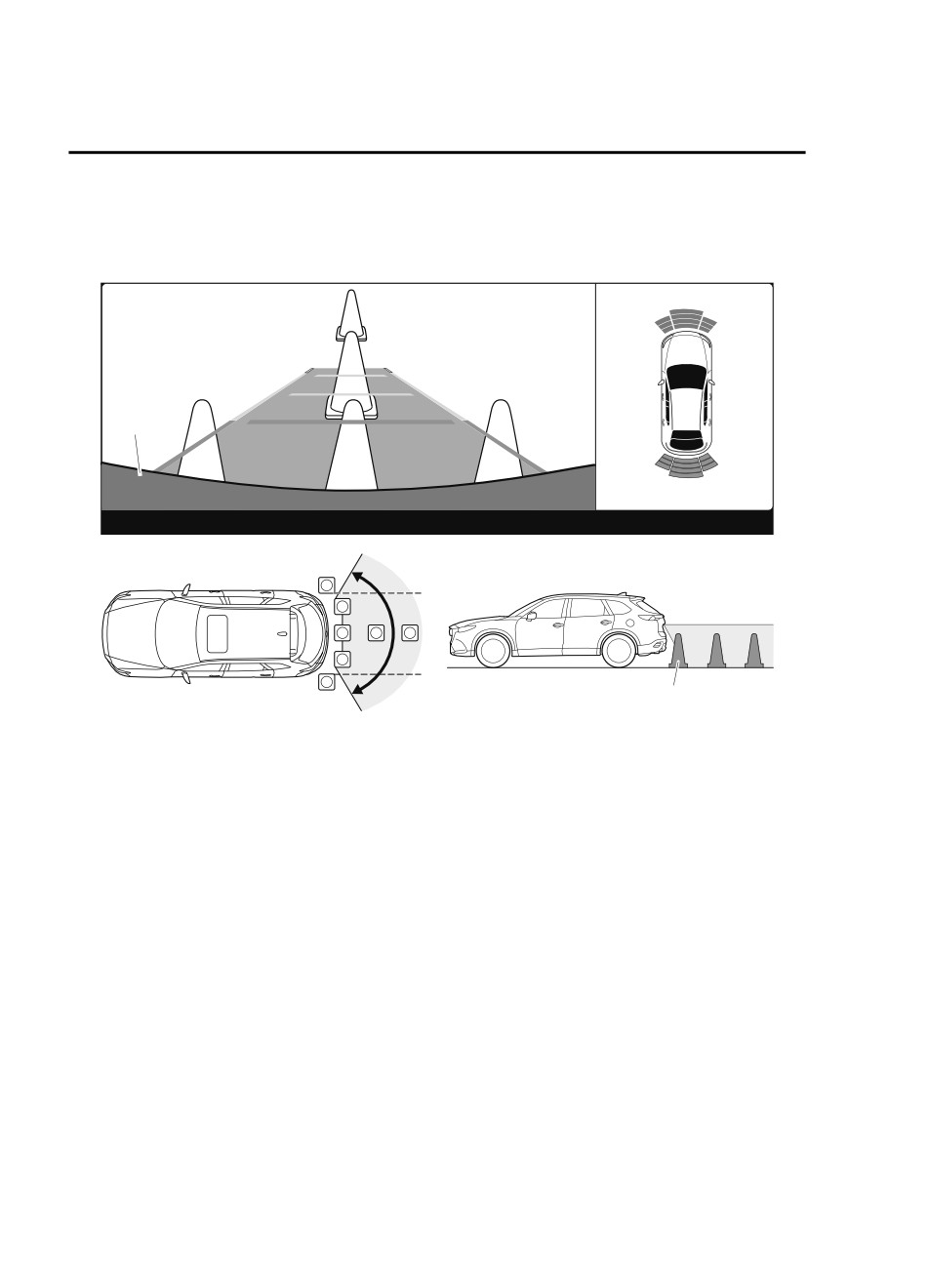
When Driving
Rear View Monitor (Mazda Connect (Type B))
▼ Displayable Range on the Screen
The images on the screen may be different from the actual conditions.
(Screen display)
Bumper
(Actual view)
Object
NOTE
The displayable range varies depending on the vehicle and road conditions.
If the camera lens is touched or there is any dirt on it, it could affect the screen image.
Wipe the lens using a soft cloth.
The displayable range is limited. Objects under the bumper or around the bumper ends
cannot be displayed.
The distance appearing in the displayed image is different from the actual distance
because the rear view parking camera is equipped with a specific lens.
Images displayed on the monitor from the rear view parking camera are reversed images
(mirror images).
Some optionally installed vehicle accessories may be picked up by the camera. Do not
install any optional parts that can interfere with the camera view, such as illuminating
parts or parts made of reflective material.
It may be difficult to see the display under the following conditions, however, it does not
indicate a malfunction.
In darkened areas.
When the temperature around the lens is high/low.
When the camera is wet such as on a rainy day or during periods of high humidity.
4-254
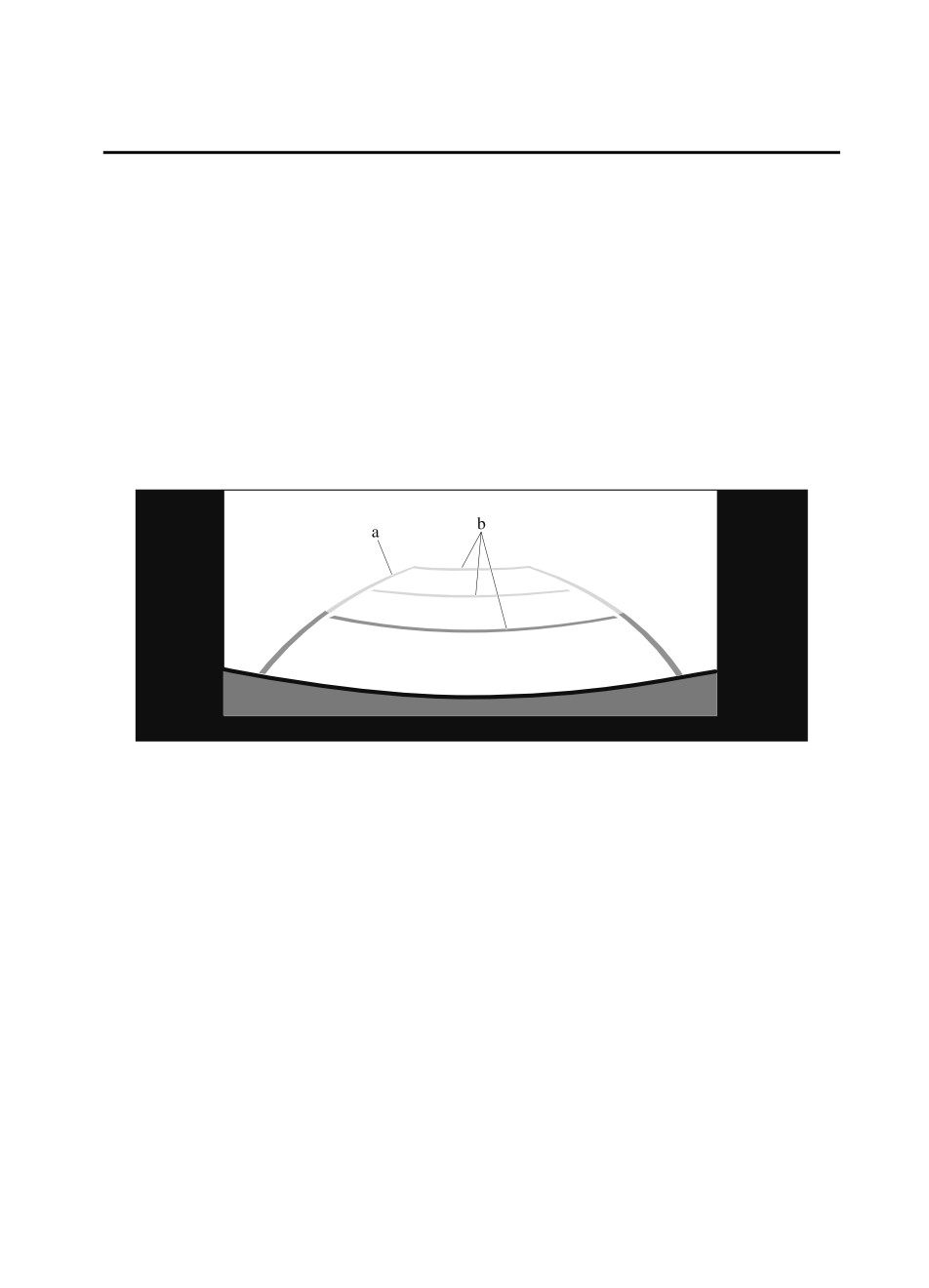
When Driving
Rear View Monitor (Mazda Connect (Type B))
When foreign material such as mud is stuck around the camera.
When the camera lens reflects sunlight or headlight beams.
The surroundings are illuminated by vehicle lights, fluorescent lights, or LED lights
(display may flicker).
Extremely small dark or white dots appear on the screen (dots may flicker).
Image display may be delayed if the temperature around the camera is low.
▼ Viewing the Display
Guide lines which indicate the width of the vehicle are displayed on the screen as a
reference to the approximate width of the vehicle in comparison to the width of the parking
space you are about to back into.
Use this display view for parking your vehicle in a parking space or garage.
a) Vehicle width guide lines
Guide lines serve as a reference to the approximate width of the vehicle.
b) Distance guide lines
These guide lines indicate the approximate distance to a point measured from the
vehicle's rear (from the end of the bumper).
The red line indicates the point about 0.5 m (19 in) from the rear bumper.
The yellow lines indicate the points about 1.0 m (39 in) and 2.0 m (78 in) from the rear
bumper.
▼ Rear View Monitor Operation
The operation of the rear view monitor when reversing the vehicle varies depending on the
traffic, road, and vehicle conditions. The amount of steering and the timing also varies
depending on conditions, so confirm the surrounding conditions directly with your eyes and
steer the vehicle in accordance with the conditions.
Be well aware of the above cautions prior to using the rear view monitor.
NOTE
Images displayed on the monitor from the rear view parking camera are reversed images
(mirror images).
4-255

When Driving
Rear View Monitor (Mazda Connect (Type B))
1. Shift the selector lever to reverse (R) position to switch the display to the rear view
monitor display.
2. Confirming the surrounding conditions, reverse the vehicle.
3. After your vehicle begins entering the parking space, continue backing up slowly so that
the distance between the vehicle width lines and the sides of the parking space on the
left and right are roughly equal.
(Display condition)
(Vehicle condition)
4. Continue to adjust the steering wheel until the vehicle width guide lines are parallel to
the left and right sides of the parking space.
5. Once they are parallel, straighten the wheels and back your vehicle slowly into the
parking space. Continue checking the vehicle's surroundings and then stop the vehicle in
4-256
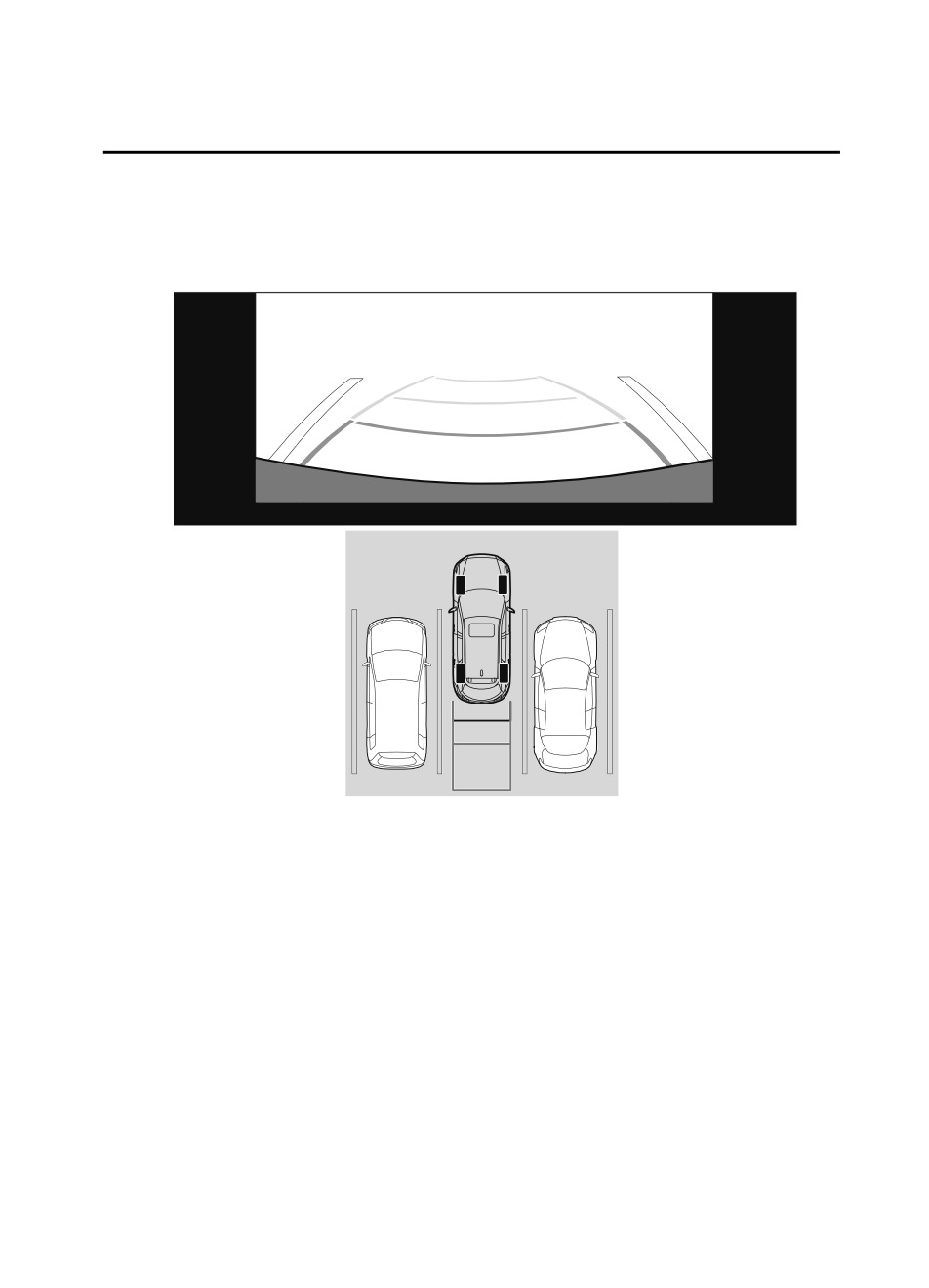
When Driving
Rear View Monitor (Mazda Connect (Type B))
the best possible position. (If the parking space has division lines, check whether the
vehicle width guide lines are parallel to them.)
(Display condition)
(Vehicle condition)
6. When the selector lever is shifted from reverse (R) position to another selector lever
position, the screen returns to the previous display.
NOTE
Because there may be a difference between the displayed image, such as indicated below,
and the actual conditions when parking, always verify the safety at the rear of the vehicle
and the surrounding area directly with your eyes.
In the image of the parking space (or garage) displayed on the screen, the back end and
distance guide lines may appear aligned in the monitor, but they may not actually be
aligned on the ground.
4-257
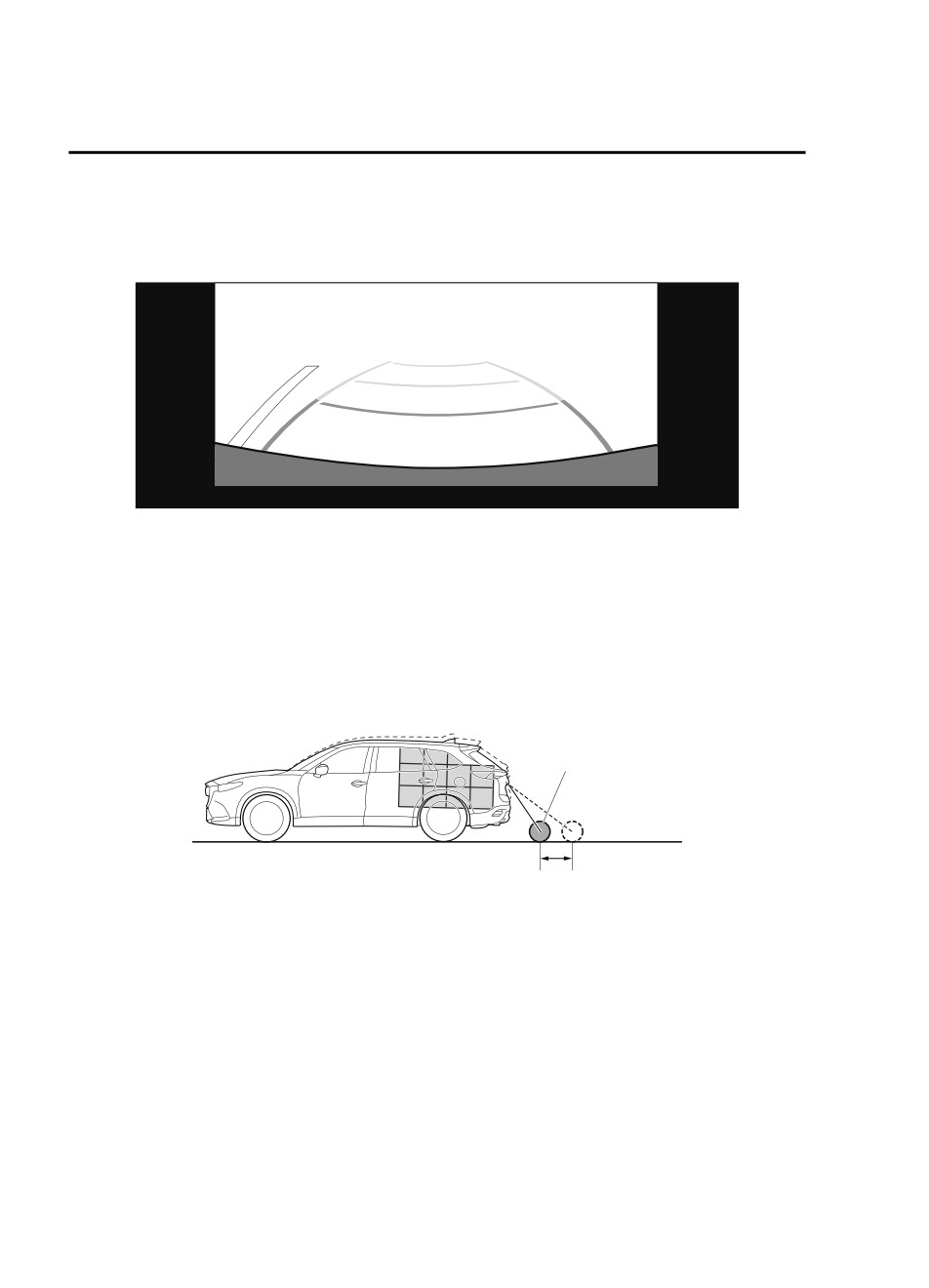
When Driving
Rear View Monitor (Mazda Connect (Type B))
When parking in a space with a division line on only one side of the parking space, the
division line and the vehicle width guide line appear aligned in the monitor, but they may
not actually be aligned on the ground.
▼ Variance Between Actual Road Conditions and Displayed Image
Some variance occurs between the actual road and the displayed road. Such variance in
distance perspective could lead to an accident. Note the following conditions that may cause
a variance in distance perspective.
When the vehicle is tilted due to the weight of passengers and load
When the vehicle rear is lowered, the object displayed on the screen appears farther than the
actual distance.
Object
Variance
4-258
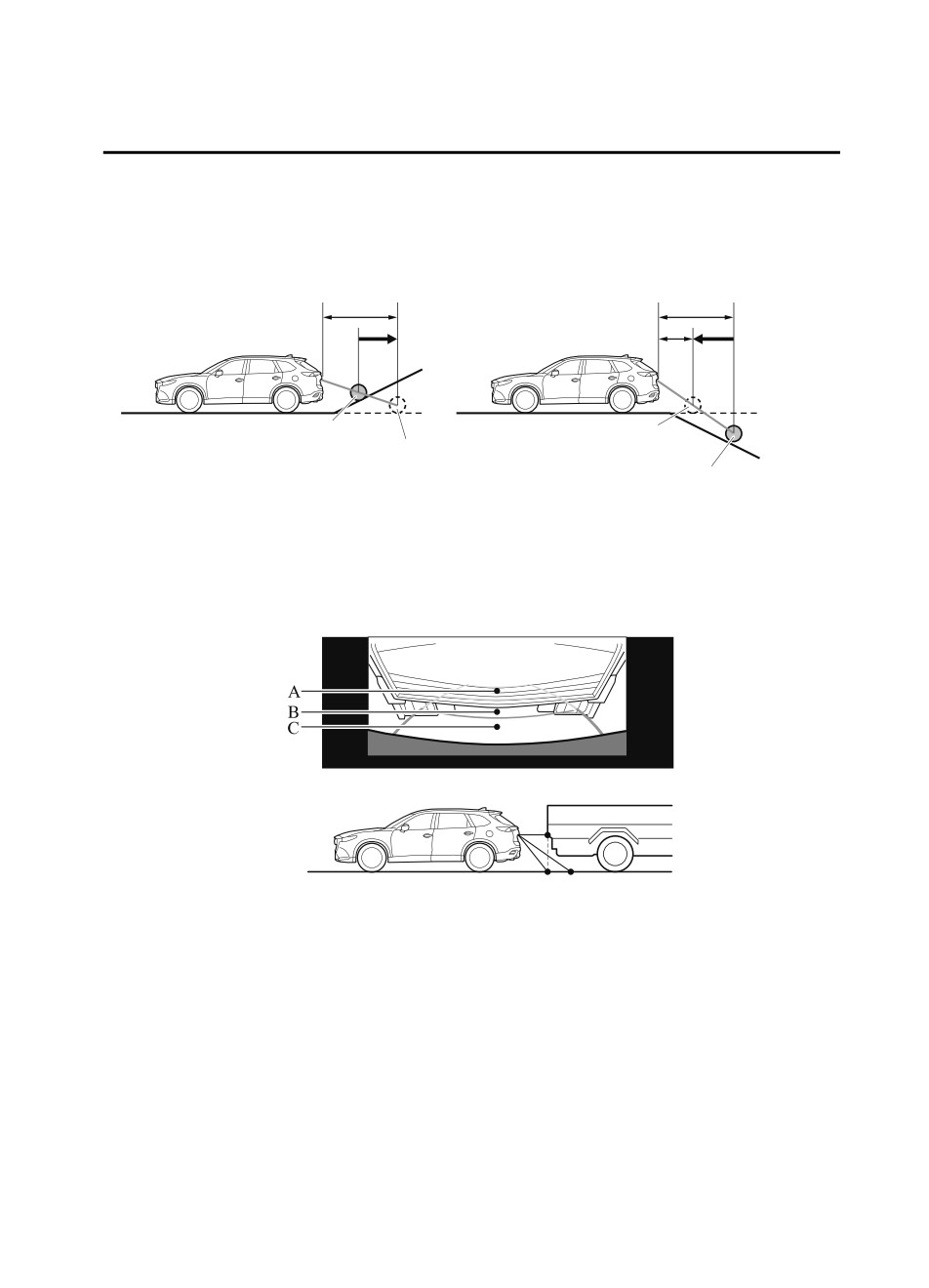
When Driving
Rear View Monitor (Mazda Connect (Type B))
When there is a steep grade behind the vehicle
When there is a steep upgrade (downgrade) behind the vehicle, the object displayed on the
screen appears farther (downgrade: closer) than the actual distance.
Appears
Appears
A
farther than
B
closer than
B
A
actual
actual
distance
distance
Object at actual position
Object on screen
Object on screen
A: Distance between the vehicle and object displayed on the screen.
Object at actual
B: Actual distance between the vehicle and object.
position
Three-dimensional object on vehicle rear
Because the distance guide lines are displayed based on a flat surface, the distance to the
three-dimensional object displayed on the screen is different from the actual distance.
(Screen display)
Sensed distance on screen A>B>C
(Actual view)
A
C B
(Actual distance) B>C=A
4-259
Большое спасибо!
Ваше мнение очень важно для нас.

Нет комментариевНе стесняйтесь поделиться с нами вашим ценным мнением.
Текст